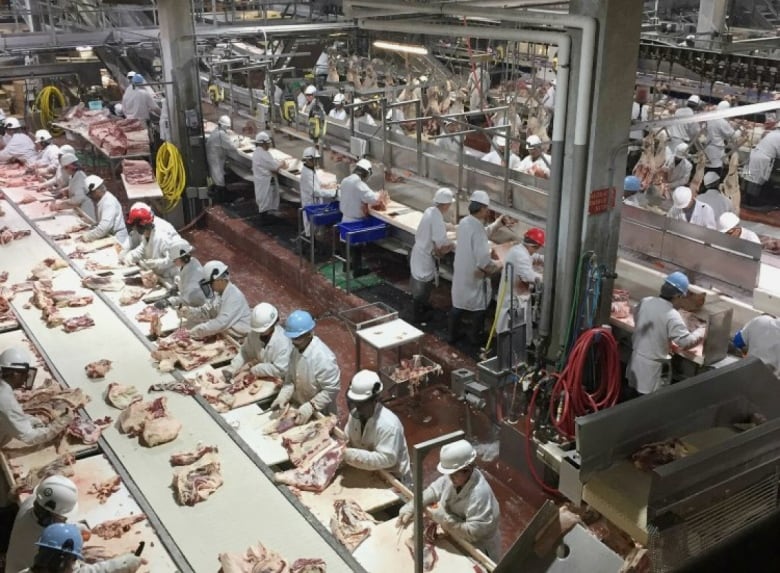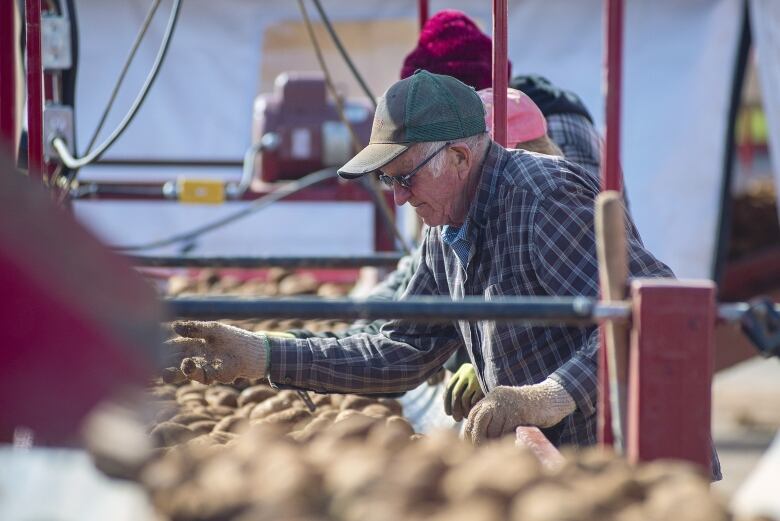The pandemic is creating a season of anxiety in hard-hit farm sectors
Canada isn't running out of food — but some producers may be running out of time

Most Canadian food sectors say the COVID-19 pandemic has presented them with problems. A lack of raw product itself isn't one of them.
There are still ample supplies of grains, oilseeds, pulses and potatoes. No shortages are anticipated.
Throughout the food chain, the greatest threats to food security appear where there is a need for a large workforce. Meat and poultry processors have plenty of animals and birds on hand, but have to contend with bottlenecks at their labour-intensive processing plants due to illness.
Producers of vegetables, who depend heavily on foreign labour and are less mechanized than growers of cereals, oilseeds, pulses and tubers, are also facing short-term difficulties.
But some producers say the real threat to food security is the danger that many farmers will go bankrupt, and their future production will be lost.
Boon to some, bane to others
The pandemic's effects have been uneven. It's been very kind to growers of peas, harsh to those who raise hogs.
Farmers who produce less perishable product for export are mostly doing well. Growers that depend heavily on the domestic food service industry — such as the people who grow potatoes — are not.
And even those who depend on exports are still waiting to see what kind of world market for food will emerge on the other side of the pandemic.
"There've been a lot of policy decisions that were made under extreme conditions," says Greg Cherewyk of Pulse Canada, which represents growers of peas, lentils, chickpeas and similar crops. "You've got everything from import bans to export control measures in place, all reacting to a very extreme and difficult time.
"When we revert back to a more normal environment, what will that new normal look like? That's the question that we're grappling with."
Food plants are backed up
The meat industry's problem is one of capacity: too many animals, not enough processing plants.
"We estimate that between 6,000 and 9,000 head of cattle a day are still being backed up within the Canadian beef supply system," Bob Lowe of the Canadian Cattlemen's Association told a Commons committee this week.
The return to operation of Canada's biggest meat-packing plant will not fundamentally change that, Lowe added.

The Cargill plant in High River, Alberta was the scene of Canada's largest single-site outbreak of the novel coronavirus, with over 1,500 cases, counting secondary infections. It represents 36 per cent of Canada's beef processing capacity.
The cattle industry was granted one of its wishes Tuesday when the federal government announced up to $125 million for a "set-aside program" — essentially government money to cover the costs of feeding livestock while they wait to get into a slaughterhouse.
A similar program was introduced during the BSE crisis in 2004. But even with that program in place back then, "27,000 beef farmers left the industry," said Lowe.
Hard times for hog farmers
While it's estimated that North America's processing capacity for beef is down by at least 10 per cent, the slowdown for hog producers has been even sharper.
"Last week in North America, 42 per cent of the plant capacity was closed, so you can just imagine how things start backing up on the farm," Rick Bergmann of the Canadian Pork Council told CBC News.
"The plants are going as fast as they can. But in Canada, and especially in Eastern Canada, there's still about 140,000 to 150,000 animals that should have gone to slaughter but haven't. These are the ones that are still down on the farm and they're getting bigger and bigger and bigger.
"It's easy to turn off the tap at the plant. It's difficult to turn off the tap on the farm, because you're basically working 11 months ahead of time."

'Our house is burning'
Although they are eligible for the same set-aside program as cattle raisers, hog farmers are unlikely to find that the money goes far enough.
"We're taking between a $30 and a $50 hit per hog," said Bergmann. "We've been told by our federal government that we're an essential service. We've been told that food security is important for Canadians and for our country.
"And we've had multiple conversations with government where we tell them, 'Look, our house is burning down, can you help us?' We need a bit of a fire truck here. And it's been too quiet for our liking."
Bergmann said hog farmers would like the government to provide about $20 per hog to help them stay in business. With 14 million hogs on Canadian farms, that would add up to more than the value of the entire federal assistance package announced for the agricultural sector this week.
Bergmann said that if a hog farm goes under, its lost production likely won't be coming back any time soon.
"We're not making backpacks or coffee mugs," he said. "We're making food so people can live.
"If producers go out of business because they're losing money, then where's our pork going to come from? Is it going to be imported?"
Fewer restaurants, fewer chickens
Chicken production is heavily dependent on restaurants and the fast food industry, Lisa Bishop-Spencer of Chicken Farmers of Canada told CBC News.
"We've been affected by a significant decrease in the food service business, which represented 40 per cent of the production of chicken in Canada," she said. "There has been a rapid increase in demand for retail product, but it hasn't been enough to make up the difference."
Compared to cattle and hog farmers, however, chicken farmers have some advantages.
"We're a supply-managed commodity," said Bishop-Spencer. "We have a little bit of flexibility in our system that allows us to adjust our production according to both consumer demand and the capacities of our value chains."
In mid-April, the Chicken Farmers of Canada board of directors agreed to reduce the sector's May-June output by 12.6 per cent nationally, and to cut output for the summer months.
Not all supply-managed sectors enjoy that luxury. Chicken producers, said Bishop-Spencer, benefit from a growing cycle shorter than those in the beef and pork sectors, which allows them to reduce output quickly.
The dairy sector is also supply-managed. But while a chicken farmer can decide to produce fewer chickens, a dairy farmer can't order cows to stop producing milk — which is why some have started dumping milk. But at least supply management ensures the dumping is done in a coordinated manner, and losses are shared across the sector.
Small order of fries
Potato growers also depend on restaurants, said P.E.I. farmer Kevin MacIsaac, president of the United Potato Growers of Canada.
"Probably about 70 per cent of our industry is dedicated towards the food service industry," MacIsaac told CBC News. "So we just don't have the volume we used to have.
"We're probably in one of the most difficult situations that I've seen in my time ..."

MacIsaac said there's still a lot of product in stock that would normally have been used by now, and orders from french fry manufacturers are down 15 to 25 per cent.
MacIsaac said matters are even worse for their counterparts in the U.S.
"The only thing we've got going for us here in Canada is that the U.S. planting season is probably two to three weeks ahead of ours, so there's a crop planted there that now has to be destroyed," he said. "I just saw this in Washington State. In Canada, we still have some opportunity to not plant those potatoes that have no market."
MacIsaac said his organization is advising farmers to plant only enough to cover their contracts. He said he expects many will sow their idle acres with lower-value crops such as wheat, soybeans or corn.
Boom times for beans
Canada is a world leader in the production of pulses, and few crops are better placed to weather the COVID-19 pandemic. Pulses are an exportable commodity that can be stored almost indefinitely once canned or dried. Their production is heavily mechanized and they don't depend on restaurants being open.
"All indications are the product is moving really well," said Greg Cherewyk of Pulse Canada. "Our pea program, which is a big chunk of our exports, is ahead about 500,000 metric tons of where it was this time last year. Lentils are 300,000 tonnes ahead of where we were same period last year.
"The COVID-19 crisis has actually led to a bit of a spike in demand in North America for pulse products. Things like shelf-able products, canned and dry-packaged goods are moving. It's what's been called the 'plan-for-the-worst' trend.
"Some of the processors we're dealing with are saying that sales are up about 40 per cent. Others are saying that shipments are as much as 400 per cent higher than where they were last year. It's safe to say we've benefited from that effort to make sure the pantry is stocked."

Russia's loss, Canada's gain
Canada's wheat farmers also are doing well.
"We are seeing a little bit of an uptick in demand that has been caused by the pandemic," said Cam Dahl of Cereals Canada. "There had been some concern that exporters like Russia and other countries around the Black Sea might limit exports, and that has increased interest in other countries because of food security. I'm seeing very strong demand in other countries for Canadian grains and oilseeds."
Dahl said the high degree of mechanization has helped the industry, but it's not the only factor.
"It is a technology-intensive industry, that is for sure," he said. "But it's also because the entire sector has taken steps to ensure the protocols are in place at the country terminals where farmers bring their produce and throughout the chain."
Wheat, durum, barley and oats remain in good supply and the system is running smoothly, from inland elevators to railway terminals and ports, and from fertilizer plants to flour mills.
A future of higher barriers
But even the Canadian agriculture sectors that are weathering the pandemic best have doubts about the future.
All predict a post-pandemic world where countries are thinking more about self-sufficiency and are less inclined to rely on imports.
"Prior to COVID-19, we were seeing a steady increase in what I would call economic nationalism," said Dahl. "There were more and more market access issues cropping up that either had the potential to limit trade or actually were limiting trade.
"I expect that to accelerate. I expect that protectionist bent to be more problematic as we come out of the pandemic."
Cherewyk agrees.
"We've all experienced a bit of a shift away from a rules-based trading environment into one where there's less transparency and less predictability," he said. "With the emphasis on ensuring that food supply is safe and stable and secure enough to meet domestic needs, what will those efforts look like? It's hard to predict right now.
"It's one thing to revert back to more-or-less normal. But how will some of the effects people have experienced during this crisis change how they look ahead?"


